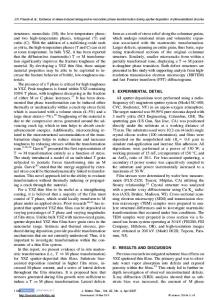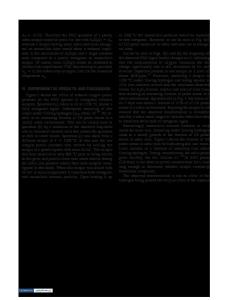Coupling between order parameter and compositional fluctuations in the irradiation induced monoclinic to tetragonal phas
- PDF / 78,435 Bytes
- 6 Pages / 612 x 792 pts (letter) Page_size
- 80 Downloads / 243 Views
R2.7.1
Coupling between order parameter and compositional fluctuations in the irradiation induced monoclinic to tetragonal phase transition in pure zirconia. D Simeone1) ,G Baldinozzi2) ,D. Gosset1) , M Dutheil1) 1)
Laboratoire d'Analyse Microstructurale des Matériaux, DMN/SRMA, CEA/Saclay F-91191 Gif sur Yvette, France. 2) Laboratoire de Structures, Propriétés et Modélisation des Solides, UMR CNRS 8580 Ecole Centrale Paris, F-92295 Chatenay Malabry, France. ABSTRACT Zirconia, oxidation product of Zircaloy cladding elements of nuclear plants, exhibits an unusual behaviour under irradiation. Impinging ions and neutrons induce a monoclinic to tetragonal phase transition at room temperature in this solid. To understand this modification of the positions of the stability lines in such a solid under irradiation, we have studied the monoclinic to tetragonal first order phase transition versus temperature in pure micrometric and nanometric zirconia samples. From these works, it was possible to understand the behaviour of this material under irradiation pointing out the key role of defects induced irradiation on its phase diagram. INTRODUCTION Zirconium alloys are used as cladding elements in nuclear plants because of the low neutron absorption cross-section of zirconium. In Pressurised Water Reactors, the oxidation of these cladding elements leads to the apparition of a zirconia layer. This layer modifies the mechanical and thermal behaviour of cladding elements and drastically diminishes their lifetime. To increase the lifetime of these elements, the behaviour of zirconia under irradiation must be studied with great attention [1]. Moreover, zirconia is an interesting technological material because of its outstanding mechanical and electrical properties [2]. In particular, the possibility to accept selective substitutions makes zirconia a good host for nuclear wastes. Assessing the stability of this structure is of paramount importance to match the severe nuclear standards. Unfortunately, under irradiation the room temperature monoclinic phase undergoes a monoclinic to tetragonal first order phase transition [2,3,4]. On a more theoretical point of view, the sensitivity of zirconia phase transitions to radiation exposure also suggests that zirconia can be a good paradigm system for modelling the effects of radiation damage on the structural instabilities. In this paper, we first describe the monoclinic to tetragonal phase transition in standard conditions within the Landau theory framework, then we focus our attention on the coupling between order parameters studying zirconia nanocrystals. Such an approach is then used to propose a mechanism to describe the monoclinic to tetragonal phase transition induced by irradiation.
R2.7.2
DESCRIPTION OF THE M-T PHASE TRANSITION VERSUS TEMPERATURE
In this structure, zirconium and oxygen atoms sit in a fluorite structure (Fm-3m) below the melting temperature (2973K). Zirconia undergoes two successive phase transitions on cooling. The former occurs near 2573 K and is second or wea
Data Loading...











